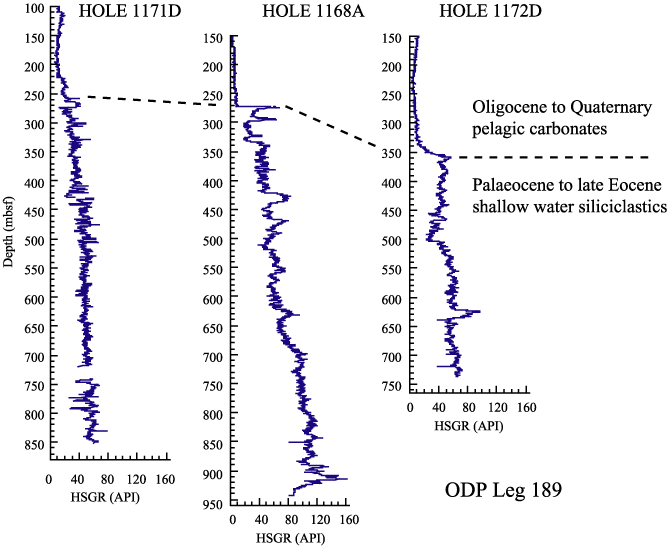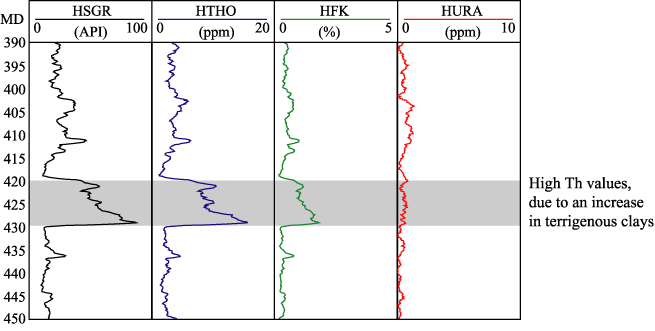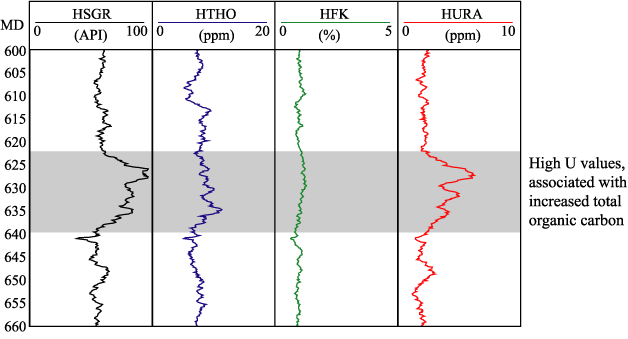Applications of gamma ray logs
Depth correlations and core-log integration
Total gamma-ray log curves, which are acquired with every toolstring combination, are normally used to depth match all of the logsobtained in any one hole. The HSGR log from the Triple Combo is used as the base curve, and the SGR logs from all the other toolstringsare interactively matched to it. The depth shift applied to each SGR curve is propagated to all other logs acquired by that toolstring.Gamma ray data can also be used for core-log integration, by correlating the natural gamma results from the whole core multisensor track (WC-MST) with the HSGR and SGR curves. Furthermore, because the gamma ray log responds principally to fluctuations in the formation’s mineralogy, rather than physical properties such as lithification, it is particularly useful for making regional, inter-hole comparisons between major lithostratigraphic units (Figure 1).

Figure 1. Regional Correlation of major lithostratiraphic units, using total gamma ray data from ODP Leg 189.
Identification of lithology, facies and depositional environment
Naturally radioactive elements tend to have a far greater concentration in shales than in other sedimentary lithologies, and therefore the total gamma-ray log and, in particular, the corrected gamma-ray log (HCGR and CGR) and the Th log are frequently used to derive a “shale volume” (see Ellis 1987 and Rider 1996). In addition, the shape of the gamma log curve may be used to reconstruct downhole fluctuations in grain size, and infer changes in sedimentary facies: the standard approach is to interpret bell shaped gamma curves as a fining-upwards sequence and funnel shaped gamma curves as a coarsening-upward sequence (Serra & Sulpice 1975). However, these methods are only likely to be of use in simple sandstone/shale formations, and are subject to error when a significant proportion of the gamma ray radioactivity originates from the sand sized detrital fraction of the rock (see Heslop 1974 and Rider 1990).
Gamma ray data may also be used to help interpret the environment of deposition. Unconformities can result in the accumulation of phosphatic nodules, which may be evident in the spectral gamma log as an anomalous spike in U. Increased U values, and in particular low Th/U ratios, may also be associated with marine condensed sequences (Myers & Wignall 1987). Doveton (1991) used Th/U ratios to estimate paleo-redox conditions at the time of deposition, which he used to identify generally transgressive and regressive intervals.
Mineralogy / Geochemistry
The concentrations of the three main radioactive elements in the formation can often be used to give an indication of the mineralogy and/or geochemistry. For example, high Th values may be associated with the presence of heavy minerals, particularly in channel sand deposits overlying an erosional unconformity. Increased Th values may also be associated with an increased input of terrigenous clays (Hassan et al. 1976) (Figure 2).

Figure 2. Spectral gamma tay data from Hole 1124C, showing high Th values in a mudstone unit between 420-430 mbsf.
Increases in U are frequently associated with the presence of organic matter. For example, particularly high U concentrations (>~5 ppm) and low Th/U ratios (<~2) occur in black shale deposits (Adams & Weaver 1958). In the Ocean Drilling Program, a correlation can often be observed between the U log and the total organic carbon values measured in the core (Figure 3)

Figure 3. Spectral gamma-ray data from Hole 1172D, showing high U values in an organic-bearing claystone unit between ~662-640 mbsf.
In sandstones, high K values may be caused by the presence of potassium feldspars or micas (Humphreys & Lott 1990, Hurst 1990). Glauconite usually produces a very distinctive, almost diagnostic spike in the K log (Figure 4).

Figure 4. Spectral gamma-ray data from Hole 1171D, showing high K values due to the presence of glauconite.
In ocean floor volcanics, K can become significantly enriched in secondary alteration minerals, which are typically found where the formation is more permeable and intense fluid-rock interactions can occur (Brewer et al. 1992). An example of this can be seen in ODP Hole 896A, where the lowest K values occur in relatively impermeable massive flows, whereas higher and more variable K concentrations can be correlated with the more permeable pillow lavas and breccias (Brewer et al, 1998).
More quantitative attempts have been made to derive a mineralogy from the spectral gamma-ray log, which generally involve cross-plotting Th against K (Quirein 1982), PEFL against K (Schlumberger 1991), or PEFL against Th/K (Schlumberger 1991). However, the validity of these methods is questionable (Hurst 1990), and it is unlikely that they are applicable in a wide variety of sedimentary environments.
Cyclostratigraphic analysis
Spectral gamma-ray data can also be used for cyclostratigraphic analysis of the formation, to help identify the frequency of paleoceanographic and/or climatic change (Figure 5). Data acquired by the recently developed Lamont Multisensor Gamma ray Tool will be particularly valuable for time series analysis, due to its very high resolution (~8 cm).

Figure 5. Spectral gamma-ray data (A) and preliminary analysis (B and C) from 1170F. The power spectrum show the results of spectral analysis over the entire logged section (B) and the interval where the Th and K data show the most pronounced cyclicity (C)
References
Adams, J.A. & Weaver, C.E. 1958. Thorium-uranium ratios as indicators of sedimentary processes: example of concept of geochemical facies. Bulletin American Association of Petroleum Geologists 42(2), 387-430.
Brewer, T.S, Pelling, R., Lovell, M.A. & Harvey, P.K. 1992. The validity of whole rock geochemistry in the study of ocean crust: a case study from ODP Hole 504B. In: Parson, L.M., Murton, B.J. & Browning, P. (eds), Ophiolites and their modern ocean analogues. Geological Society of London Special Publication No. 60, 263-278.
Brewer, T.S, Harvey, P.K., Lovell, M.A., Haggas, S., Williamson, G & Pezard, P. 1998. Ocean floor volcanism: constraints from the integration of core and downhole logging measurements. In : Harvey, P.K. & Lovell, M.A. (eds), Geological Society of London Special Publication No. 136, 341-362.
Doveton, J.D. 1991. Lithofacies and geochemical facies profiles from nuclear wireline logs: new subsurface templates for sedimentary modelling. In: Franseen, E.K., Watney, W.L., Kendall, C.J. & Ross, W. (eds), Sedimentary modelling-computer simulations and methods for improved parameter definition. Kansas Geological Society Bulletin 233, 101-110.
Ellis, D.V., 1987. Well logging for earth scientists. Elsevier, Amsterdam.
Hassan, M., Hossin, A. & Combaz, A. 1976. Fundamentals of the differential gamma ray log interpretation technique. SPWLA 17th Annual. Symposium Transactions Paper 8, 1-7.
Heslop, A. 1974. Gamma-ray log response of shaly sandstones. Trans. SPWLA, McAllen, Texas.
Hurst, A. 1990. Natural gamma-ray spectrometry in hydrocarbon-bearing sandstones from the Norwegian Continental Shelf. In: Hurst, A., Lovell, M.A. & Morton, A.C. (eds), Geological Application of Wireline Logs, Geological Society of London Special Publication No. 48, 211-222.
Humphreys, B. & Lott, G.K. 1990. An investigation into nuclear log responses of North Sea Jurassic sandstones using mineralogical analysis. n: Hurst, A., Lovell, M.A. & Morton, A.C. (eds) Geological Application of Wireline Logs, Geological Society of London Special Publication No 48, 223-240.
Quirein, J., Gardner, J.S. & Watson, J.T. 1982. Combined natural gamma ray spectral/lithodensity measurements applied to complex lithologies. SPE 11143, 57th Annual Fall Technical Conference and Exhibition of SPE and AIME, New Orleans, Sept. 26-29.
Rider, M. 1990. Gamma-ray log shape used as a facies indicator: critical analysis of an oversimplified method. In: Hurst, A., Lovell, M.A. & Morton, A.C. (eds), Geological application of wireline logs. Geological Society of London Special Publication No 48, 27-37.
Rider, M. 1996. The Geological Interpretation of Well Logs: Caithness (Whittles Publishing).
Schlumberger, 1991. Log interpretation charts. SMP-7006, Schlumberger Wireline & Testing.
Serra, O. & Sulpice, L. 1975. Sedimentological analysis of shale-sand series from well logs. Transactions of the SPWLA 16th Annual Logging Symposium, paper W.
